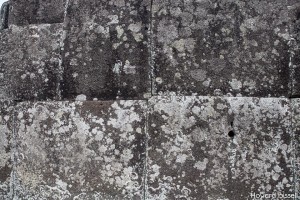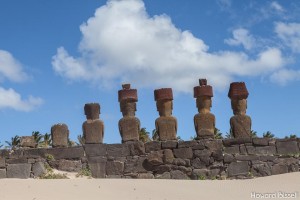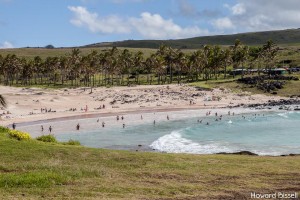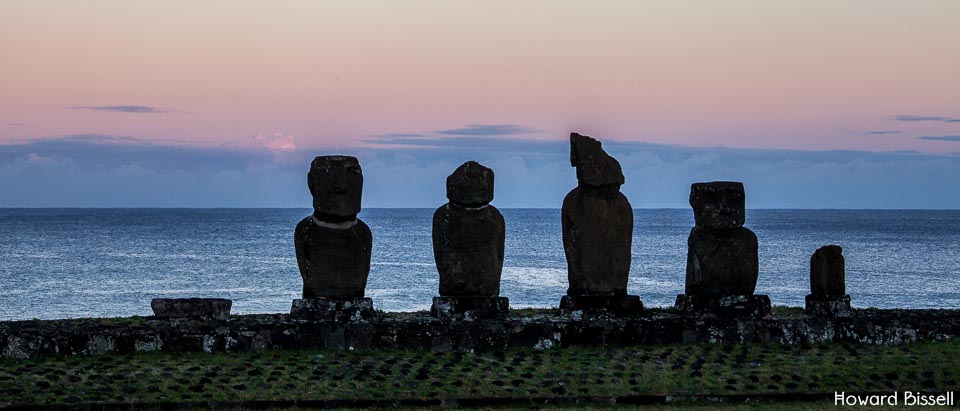The guys go out for sunrise photos at the nearby harbor and I’m happy to stay at “home.” According to Howard, the street dogs greet them affectionately but that’s the best thing about their early morning outing.
Our first stop of the day is Vinapu. There are 3 platforms here but only 2 are prominent. Ahu Tahira displays 6 overthrown statues, face down, with 3 red topknots lying in front of them. The feature of interest here is the platform masonry–the fit of the stones has indicated to some researchers that there is a connection to Inca stonework. Recent hypothesis instead has it that the natives of Easter Island spread their knowledge to South America (voyaged there) rather than the other way.
Recent hypothesis instead has it that the natives of Easter Island spread their knowledge to South America (voyaged there) rather than the other way.
The second prominent platform is Ahu Vinapu. It appears to have had at least 5 Moias with several topknots; they are all on the ground now. There is also a statue that was unearthed in 1956 that was amazingly (and uniquely) made out of the red rock normally only used for the topknots. The figure appears to have thin arms and hands as well as slight breasts and a pronounced belly button indicating it was a female image. That is very unusual. There is a sketch of this statue dated 1868 that shows that this statue may have has 2 heads in a Y-shape. It’s possible that it was used as a funerary pillar on which a stretcher containing the body was hung on the 2 “heads” to dry before cremation.
It’s begun to rain. We take the east coast road and stop at every Ahu (platform) along that route. The 3 of us feel that something’s been lost because so many Moias have been left face-down in the soil to decompose. Many of the Moias on the ground are partially or almost completely buried. Our gut response is that it’s disrespectful to…what? The gods? The ancestors? It still seems not right. I suppose we can see some reason to leave the broken statues sprawled on the ground–after all it was the native people who destroyed the Moais. But still…
There are many rock piles that appear to be the beginnings of an Ahu (platform) but have not been formally leveled and of course they have no Moais on top of them yet. We head on back to town for lunch at Donde el Gordo. Frieder recommended this sandwich shop for a good lunch. We sit outside but the wind is blowing and next store they are grinding tiles for the walkway. Not a pleasant lunchtime atmosphere. The unique attribute of the sandwiches is green beans…as a sandwich ingredient. It was actually quite a nice condiment.
Our afternoon stop is at the quintessential South Pacific beach: white sands; beautiful palm trees; warm and moist breezes; and Moais (!). We arrive at Anakena on the north coast to see 4 Moais on one platform, Ahu Nau Nau. Its platform was restored in 1978. These Moais show an incredible amount of carving detail. There are fragments of other Moais and topknots lying in the sand . Also these Moais are unique because there are carvings on their backs. There are also petroglyphs on the back of the platforms.
There are also petroglyphs on the back of the platforms.
Ahu Ature Huki is the second visible platform here. The single Moais has the distinction of being the first Moais to be re-erected. In 1956 Thor Heyerdahl tested his theory of the ancient method of raising of the Moais. His method was to raise the statue from a horizontal position (assuming the statues were moved by a sled of sorts) using long poles and stone supports.
This is where it is believed the first settlers arrived. It is the largest white sand beach; all other island inlets (with the exception of one other small beach) are treacherous rock landings.
It is the largest white sand beach; all other island inlets (with the exception of one other small beach) are treacherous rock landings.
We arrive back home about 7pm. Howard and I just veg in the hotel room eating leftovers from lunch, potato chops, chocolate and, oh yea, Pisco Sours.
